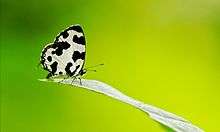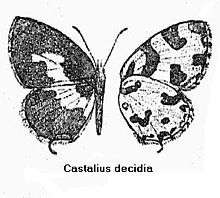Caleta caleta
| Angled Pierrot | |
|---|---|
 | |
| In Madayipara, Kerala, India | |
| Scientific classification | |
| Kingdom: | Animalia |
| Phylum: | Arthropoda |
| Class: | Insecta |
| Order: | Lepidoptera |
| Family: | Lycaenidae |
| Genus: | Caleta |
| Species: | C. caleta |
| Binomial name | |
| Caleta caleta (Hewitson, 1876) | |
| Synonyms | |
|
Castalius decidia | |
Caleta caleta, the angled Pierrot, [1] is a species of blue butterfly found in South Asia.
Description

The male's upperside is dark brownish black, a broad medial oblique white band across both forewings and hindwings, not extended on the forewing above vein 5, above vein 3 produced shortly outwards and downwards into a hook-like form. Underside: white with the following black markings: On forewing a short, outwardly-pointed, oblique, clavate (club-shaped) streak from base joined below to a semi-circular broad band that reaches the costa; a short, outwardly oblique, upper diseal bar, its outer edge generally emarginate; the apex, the terraen narrowly, a large irregular sub-quadrate spot touching it in the middle and a very large inwardly oblique irregular spot or mark close to the tornus. On the hindwing: a hook-shaped mark at base sometimes slender; an inwardly oblique short clavate bar from apex, three coalescent spots extended outwards from the dorsum above the tornus formed into a sinuate (sinuous) irregular mark; a spot further outwards in interspace 4; a terminal series of slender lunules and an ancillary fine line. Antennae, head, thorax and abdomen black; beneath: the palpi, thorax and abdomen white.
Female. Similar to the male on both upper and under sides, but on the former the white medial band is narrower, on the latter the black markings are broader. Antennae, head, thorax and abdomen as in the male.[2]
Range
The butterfly is found in Sri Lanka, peninsular India, Madhya Pradesh, south Bihar, Odisha, and in the Himalayas from Sikkim to Assam and onto Myanmar. The butterfly is also found in southern Sulawesi, Basilan, and Mindanao.[1]
Status
It is common in Sikkim up to 300 m though it has been recorded up to 2800 m in southern parts. It is abundant in the monsoons.[3] It is not rare over the Indian range as per Mark Alexander Wynter-Blyth.[4]
Habits

The butterfly flies rapidly, close to the ground visiting low flying bushes. Found along nullahs and shady paths. It visits damp patches.[3]
The species is found in jungle and lightly forested country with moderate to heavy precipitation.[4]
Life history
Larva
"Feeds on the tender leaves of the chorna (Zizyphus rugosa) .... pale green, of the usual woodlouse form, with the head concealed under the second segment. The whole body is more or less pubescent and there is a fringe of longer hairs on each side." (Davidson and Aitken quoted in Bingham, 1907)
Pupa
"Short and stout, constricted between the thorax and abdomen, clothed with short hair, closely attached by tail and band to any convenient surface; colour ochreous mottled with brown." (Davidson and Aitken quoted in Bingham, 1907). [2]
Similar to that of Castalius ethion but has two green bands on the back.[3]
Imago
Dry-season form is smaller with less prominent markings.[3]
Food plant
- Zizyphus rugosa, Rhamnaceae.[3]
Gallery
-
At Bangalore, Karnataka
-
_in_Talakona_forest%2C_AP_W_IMG_8599.jpg)
Wet-season form at Talakona forest, in Chittoor district of Andhra Pradesh, India
-

See also
- Caleta decidia, a blue butterfly species
- List of butterflies of India (Lycaenidae)
References
- Kunte, Krushnamegh (2000). Butterflies of Peninsular India. India, A Lifescape. Hyderabad, India: Universities Press. ISBN 978-8173713545.
- 1 2 Markku Savela's website on Lepidoptera Page on Caleta genus.
- 1 2 Bingham, C.T. (1907). The Fauna of British India, Including Ceylon and Burma. II (1st ed.). London: Taylor and Francis, Ltd. (description of Castalius decidia).
- 1 2 3 4 5 Haribal, Meena (1992). The Butterflies of Sikkim Himalaya and Their Natural History. Gangtok, Sikkim, India: Sikkim Nature Conservation Foundation. p. 9.
- 1 2 Wynter-Blyth, Mark Alexander (1957). Butterflies of the Indian Region. Bombay, India: Bombay Natural History Society. pp. 259–260. ISBN 978-8170192329.